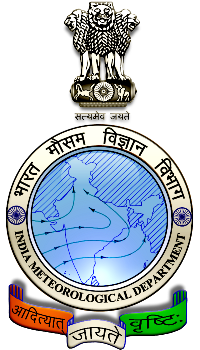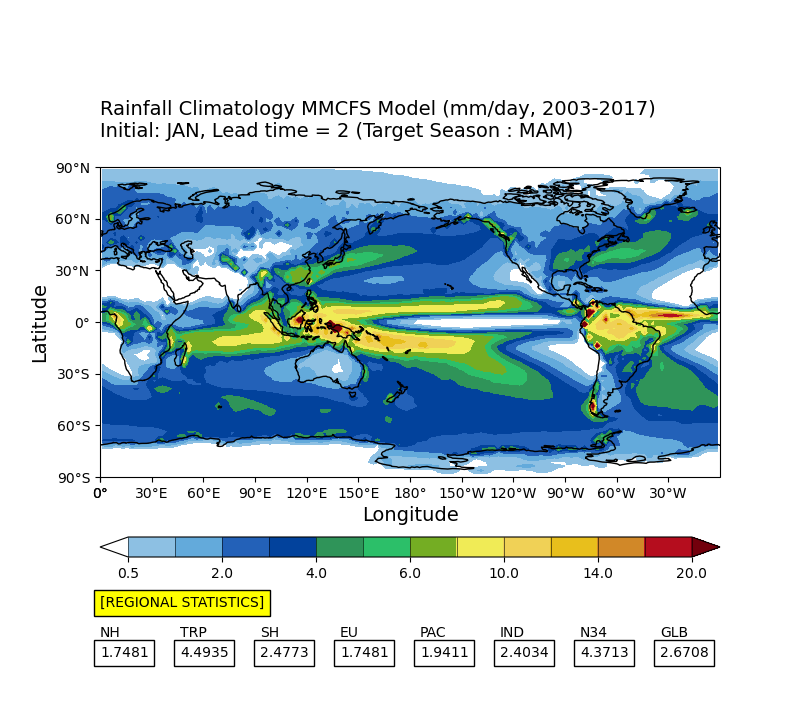

What are WMO RCCs
WMO Regional Climate Centers (RCCs) are centres of excellence that create regional products including long-range forecasts that support regional and national climate activities, and thereby strengthen the capacity of WMO Members in a given region to deliver better climate services to national users.
Mandatory RCC Functions
WMO RCCs perform the following set of mandatory functions covering the domains of long-range forecasting (LRF), climate monitoring, data services and training.
- Operational Activities for Long-range Forecasting
- Operational Activities for Climate Monitoring
- Operational Data Services, to support operational LRF and climate monitoring
- Training in the use of operational RCC products and services
Interpret and assess relevant LRF products from GPCs, distribute
relevant information to RCC Users, and provide feedback to GPCs. Generate regional and sub-regional tailored
products, relevant to RCC user needs, including seasonal outlooks etc. Perform verification of RCC quantitative
LRF products, including the exchange of basic forecast and hindcast data. Generate consensus statement on regional
or sub-regional forecasts.
Perform climate diagnostics including analysis of climate variability and extremes,
at regional and sub-regional scales. Establish a historical reference climatology
for the region and/or sub-regions. Implement a regional climate watch.
Develop quality controlled regional climate datasets, gridded where applicable.
Provide climate database and archiving services.
Provide information on methodologies and product specifications for
mandatory RCC products, and provide guidance on their use. Coordinate
training for RCC Users in interpretation and use of mandatory RCC products.
SASCOF
IMD has taken responsibility for the preparation of annual regional forecast outlook for the SW Monsoon Season rainfall under the regional forum known as the South Asian Climate Outlook Forum (SASCOF). The idea of establishing SASCOF was originated in a meeting convened by WMO, the Directors General of the National Meteorological and Hydrological Services (NMHSs) in South Asia and Permanent Representatives (PRs) of the respective countries with WMO, at the Abdus Salam International Centre for Theoretical Physics (ICTP), Trieste, Italy, on 6 August 2009. The PRs of south Asian nations with the WMO had unanimously agreed to implement SASCOF for southwest monsoon season from 2010 onwards. The first three (during 2010-2012) and fifth (during 2014) meetings of SASCOF was hosted by India Meteorological Department and held at Pune. The fourth session (in 2013) of the SASCOF was held at Kathmandu, Nepal and sixth session (in 2015) was held at Dhaka, Bangladesh. SASCOFs are generally conducted during the 3rd week of the April month each year. The main activity during all the SASCOFs was the preparation and issuing of a consensus outlook for the southwest monsoon rainfall over South Asia. Associated with last 5 SASCOFs, Training workshops on seasonal prediction were also held.
IMD has taken responsibility for the preparation of annual regional forecast outlook for the SW Monsoon Season rainfall under the regional forum known as the South Asian Climate Outlook Forum (SASCOF). The idea of establishing SASCOF was originated in a meeting convened by WMO, ... (read more)
ABOUT NCC
National Climate Centre (NCC), Pune which was established in 1995 by India Meteorological
Department (IMD) with an objective to provide various climate related services to the country
(India). NCC has been carrying out many India specific climate related activities like Climate
Monitoring and Analysis, Climate Data Management, Climate Research and Climate Prediction
(Seasonal Forecasts). NCC is bringing out climate diagnostic bulletins regularly and different
climate data products are prepared for the user community. Operational Seasonal forecast for
rainfall over the country is another important activity of the NCC.
From May 2013, NCC has started to work as WMO recognized RCC (Pilot Phase) for the south Asia.
For this, NCC started to prepare several climate monitoring and long range forecast products for
south Asia. These products include monthly and seasonal rainfall and 2m temperature anomaly maps
for the south Asia, season forecast outlook for temperatures and rainfall for south Asian countries,
ENSO and IOD forecast bulletin etc. These products are updated every month.
National Climate Centre (NCC), Pune which was established in 1995 by India Meteorological Department (IMD) with an objective to provide various climate related services to the country (India). NCC has been carrying out many India specific climate related activities like Climate Monitoring and Analysis, Climate Data Management, Climate Research and Climate Prediction (Seasonal Forecasts). ...(read more)
Extended Range Forecast
The extended range forecasting (forecasts between 7 and 30 days) fills the gap between medium-range weather forecasting and seasonal forecasting. It is often considered a difficult time range for weather forecasting, since the time scale is sufficiently long so that much of the memory of the atmospheric initial conditions is lost, and it is probably too short so that the variability of the ocean is not large enough, which makes it difficult to beat persistence. Since the Madden Julian Oscillation (MJO) is the most important mode of tropical intraseasonal variability with potentially important influences on the monsoon activity in the Asian regions, the capability of statistical or numerical models in capturing MJO signal is very crucial in capturing the active/break cycle of monsoon.
The extended range forecasting (forecasts between 7 and 30 days) fills the gap between ...(read more)

Model Products for Severe Weather Guidance for South Asia
Customised NWP and ERF products are being generated for South Asian countries for general Weather forecasting, severe weather forecasting and disaster management. ( For More information:Click here)
High-resolution simulations of 20th century climatic variations and future climate projections
Have been developed at CCCR-IITM, using a global climate model with telescopic zooming (~35 km in longitude x 35 km in latitude) over the South Asian region. These high-resolution simulations, which were performed on the PRITHVI High Performance Computing (HPC) facility at IITM, offer new opportunities to better understand several key regional scientific issues concerning climate change over South Asia - e.g., Monsoons, precipitation extremes, heat waves, droughts and floods, changes in cyclonic weather systems, hydrological cycle etc. ( For More information : Click here )
New book on Assessment of Climate Change over the Indian Region
Reanalysis Data Services
The Indian Monsoon Data Assimilation and Analysis reanalysis (IMDAA) is a regional atmospheric reanalysis over the Indian subcontinent. The IMDAA is the result of collaboration among the Met Office (MO), U.K, National Centre for Medium Range Weather Forecasting (NCMRWF), India and the India Meteorological Department (IMD) with funding from the National Monsoon Mission (NMM) project of the Ministry of Earth Sciences, Government of India. This data web portal contains (1) IMDAA Data - high resolution (12km, 1-hourly) regional reanalysis over India, from 1979 to 2018 and (2) NGFS Data - high resolution (25km, 6-hourly) Global reanalysis, from 1999 to 2018. ( For More information : Click here )
Important links:
Visitors Since
Contact Us
1st October, 2022
- 2
- 7
- 2
- 6
- 1
- 7
Head, Climate Monitoring and Prediction Group, India Meteorological Department, Shivajinagar, Pune. Email : crs-cmpg@imd.gov.in
Design, Developed and Maintained by IT Cell, O/o Climate Research & Services, Pune

